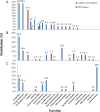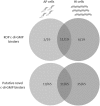An Extended Cyclic Di-GMP Network in the Predatory Bacterium Bdellovibrio bacteriovorus
- PMID: 26324450
- PMCID: PMC4686195
- DOI: 10.1128/JB.00422-15
An Extended Cyclic Di-GMP Network in the Predatory Bacterium Bdellovibrio bacteriovorus
Abstract
Over the course of the last 3 decades the role of the second messenger cyclic di-GMP (c-di-GMP) as a master regulator of bacterial physiology was determined. Although the control over c-di-GMP levels via synthesis and breakdown and the allosteric regulation of c-di-GMP over receptor proteins (effectors) and riboswitches have been extensively studied, relatively few effectors have been identified and most are of unknown functions. The obligate predatory bacterium Bdellovibrio bacteriovorus has a peculiar dimorphic life cycle, in which a phenotypic transition from a free-living attack phase (AP) to a sessile, intracellular predatory growth phase (GP) is tightly regulated by specific c-di-GMP diguanylate cyclases. B. bacteriovorus also bears one of the largest complement of defined effectors, almost none of known functions, suggesting that additional proteins may be involved in c-di-GMP signaling. In order to uncover novel c-di-GMP effectors, a c-di-GMP capture-compound mass-spectroscopy experiment was performed on wild-type AP and host-independent (HI) mutant cultures, the latter serving as a proxy for wild-type GP cells. Eighty-four proteins were identified as candidate c-di-GMP binders. Of these proteins, 65 did not include any recognized c-di-GMP binding site, and 3 carried known unorthodox binding sites. Putative functions could be assigned to 59 proteins. These proteins are included in metabolic pathways, regulatory circuits, cell transport, and motility, thereby creating a potentially large c-di-GMP network. False candidate effectors may include members of protein complexes, as well as proteins binding nucleotides or other cofactors that were, respectively, carried over or unspecifically interacted with the capture compound during the pulldown. Of the 84 candidates, 62 were found to specifically bind the c-di-GMP capture compound in AP or in HI cultures, suggesting c-di-GMP control over the whole-cell cycle of the bacterium. High affinity and specificity to c-di-GMP binding were confirmed using microscale thermophoresis with a hypothetical protein bearing a PilZ domain, an acyl coenzyme A dehydrogenase, and a two-component system response regulator, indicating that additional c-di-GMP binding candidates may be bona fide novel effectors.
Importance: In this study, 84 putative c-di-GMP binding proteins were identified in B. bacteriovorus, an obligate predatory bacterium whose lifestyle and reproduction are dependent on c-di-GMP signaling, using a c-di-GMP capture compound precipitation approach. This predicted complement covers metabolic, energy, transport, motility and regulatory pathways, and most of it is phase specific, i.e., 62 candidates bind the capture compound at defined modes of B. bacteriovorus lifestyle. Three of the putative binders further demonstrated specificity and high affinity to c-di-GMP via microscale thermophoresis, lending support for the presence of additional bona fide c-di-GMP effectors among the pulled-down protein repertoire.
Copyright © 2015, American Society for Microbiology. All Rights Reserved.
Figures





Similar articles
-
Discrete cyclic di-GMP-dependent control of bacterial predation versus axenic growth in Bdellovibrio bacteriovorus.PLoS Pathog. 2012 Feb;8(2):e1002493. doi: 10.1371/journal.ppat.1002493. Epub 2012 Feb 2. PLoS Pathog. 2012. PMID: 22319440 Free PMC article.
-
The structure of an unconventional HD-GYP protein from Bdellovibrio reveals the roles of conserved residues in this class of cyclic-di-GMP phosphodiesterases.mBio. 2011 Oct 11;2(5):e00163-11. doi: 10.1128/mBio.00163-11. Print 2011. mBio. 2011. PMID: 21990613 Free PMC article.
-
Cyclic Di-GMP Regulates Multiple Cellular Functions in the Symbiotic Alphaproteobacterium Sinorhizobium meliloti.J Bacteriol. 2015 Nov 16;198(3):521-35. doi: 10.1128/JB.00795-15. Print 2016 Feb 1. J Bacteriol. 2015. PMID: 26574513 Free PMC article.
-
Cyclic Dinucleotide-Controlled Regulatory Pathways in Streptomyces Species.J Bacteriol. 2016 Jan 1;198(1):47-54. doi: 10.1128/JB.00423-15. J Bacteriol. 2016. PMID: 26216850 Free PMC article. Review.
-
When the PilZ don't work: effectors for cyclic di-GMP action in bacteria.Trends Microbiol. 2012 May;20(5):235-42. doi: 10.1016/j.tim.2012.02.008. Epub 2012 Mar 21. Trends Microbiol. 2012. PMID: 22444828 Review.
Cited by
-
Structural basis for activation of a diguanylate cyclase required for bacterial predation in Bdellovibrio.Nat Commun. 2019 Sep 9;10(1):4086. doi: 10.1038/s41467-019-12051-6. Nat Commun. 2019. PMID: 31501441 Free PMC article.
-
Production of 3',3'-cGAMP by a Bdellovibrio bacteriovorus promiscuous GGDEF enzyme, Bd0367, regulates exit from prey by gliding motility.PLoS Genet. 2022 May 27;18(5):e1010164. doi: 10.1371/journal.pgen.1010164. eCollection 2022 May. PLoS Genet. 2022. PMID: 35622882 Free PMC article.
-
A Two-Component System That Modulates Cyclic di-GMP Metabolism Promotes Legionella pneumophila Differentiation and Viability in Low-Nutrient Conditions.J Bacteriol. 2019 Aug 8;201(17):e00253-19. doi: 10.1128/JB.00253-19. Print 2019 Sep 1. J Bacteriol. 2019. PMID: 31209078 Free PMC article.
-
Hydrodynamic Hunters.Biophys J. 2017 Mar 28;112(6):1282-1289. doi: 10.1016/j.bpj.2017.02.011. Biophys J. 2017. PMID: 28355554 Free PMC article.
-
Distinct dynamics and proximity networks of hub proteins at the prey-invading cell pole in a predatory bacterium.J Bacteriol. 2024 Apr 18;206(4):e0001424. doi: 10.1128/jb.00014-24. Epub 2024 Mar 12. J Bacteriol. 2024. PMID: 38470120 Free PMC article.
References
-
- Hobley L, Fung RKY, Lambert C, Harris MATS, Dabhi JM, King SS, Basford SM, Uchida K, Till R, Ahmad R, Aizawa S-I, Gomelsky M, Sockett RE. 2012. Discrete cyclic di-GMP-dependent control of bacterial predation versus axenic growth in Bdellovibrio bacteriovorus. PLoS Pathog 8:e1002493. doi: 10.1371/journal.ppat.1002493. - DOI - PMC - PubMed
Publication types
MeSH terms
Substances
LinkOut - more resources
Full Text Sources
Molecular Biology Databases

